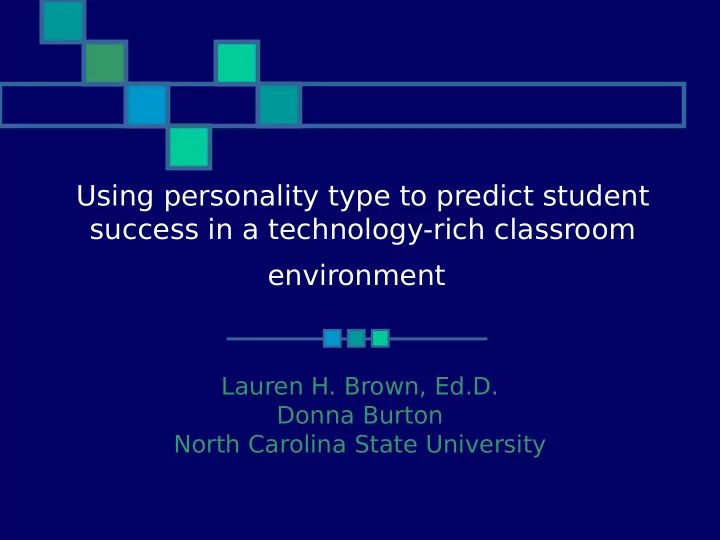

Using personality type to predict student success in a technology-rich classroom environment Lauren H. Brown, Ed.D. Donna Burton North Carolina State University
Why do this research? Personal Interest Millennial generation Adviser connections Student Success
The Millennials Generational Difgerences Parental ties Digital Generation Prevalence of technology Class Communication Personal life Faculty/student relationships
Personality Theory Why personality theory? Carl Jung Isabel Myers and Katherine Briggs- Myers The dimensions Population difgerences
Personality Theory in the Classroom Information gathering T eaching vs. Learning- dissonance
T echnology in the Classroom Uses Age difgerences Instructor preference Congruence with students’ learning North Carolina State University
Personality Theory and T echnology in the Classroom Instructor use Student use The internet Lack of research
The TF and SN Dimensions and T echnology Decision making Thinking Feeling Information gathering Sensing Intuiting
The Problem The new students and advisers/faculty Personality theory and success in the new environment Lack of specifjc, predictive research
Purpose T o further investigate if a student’s personality type, specifjcally on the Sensing/Intuiting and Thinking/Feeling scales, can be used to predict success in a technology- rich classroom environment.
Research Questions What is the predictive value of an individual’s preference for Sensing vs. Intuiting on achievement in a model that controls for gender difgerences and SAT score? What is the predictive value of an individual’s preference for Thinking vs. Feeling on achievement in a model that controls for gender difgerences and SAT score?
Conceptual Framework Achievement in a high-technology environment represented by end-of semester grade in Chemistry 101 Sensing/Intuition Thinking/Feeling Gender SAT Score
Methodology Design Population and Sample The MBTI Validity Reliability Data Collection Data Analysis
Descriptive Statistics Gender Frequency Percent Male 365 55.3 Female 295 44.7 Variable N Mean Standard Deviation Minimum Maximum SAT_T 660 1179.71 107.63 830 1490 CH_101 660 2.41 1.16 0 4.33 PREF_SN 660 11.68 8.07 1 30 PREF_TF 660 11.67 7.88 1 30 PREFSN 660 1.997 14.07 -30 30 PREFTF 660 -3.16 13.73 -30 30
Correlation Statistics Variable Variable Correlation Coefficient Pr > r CH_101 SAT_T .25 <.0001 GENDER (F=5.01) .026 SN (F=5.10) .024 TF (F=9.28) .002 PREFTF .15 .0002 PREFSN .06 .098 GENDER SAT_T -.12 .002 TF -.33 <.0001 PREFTF -.36 <.0001 SAT_T SN -.22 <.0001 TF .11 .006 PREFSN -.27 <.0001 PREFTF .12 .003
Regression Analysis- Model 1 Variable DF Parameter Standard t Pr > t Standardized Regression Estimate Error value Coefficient Intercept 1 -1.59 .50 -3.17 .001 GENDER 1 .36 .09 3.98 <.0001 .16 SAT_T 1 .003 .0004 7.32 <.0001 .28 SN 1 .30 .09 3.35 . 0009 .13 TF 1 .30 .09 3.15 . 0017 .12 Model 1: DF 4, Sum of Squares 96.09, Mean Square 24.02, F-Value 19.99, Pr>F <.0001 R-Square .11
Regression Analysis- Model 2 Variable DF Parameter Standard t Pr > t Standardized Regression Estimate Error value Coefficient Intercept 1 -1.22 .50 -2.43 .0152 <.0001 GENDER 1 .39 .09 4.19 .17 SAT_T 1 .003 .0004 7.06 <.0001 .27 PREFSN 1 .008 .003 2.40 .02 .10 PREFTF 1 .01 .003 3.77 .0002 .15 Model 2: DF 4, Sum of Squares 98.08, Mean Square 24.52, F-value 20.46, Pr>F <.0001, R-Square .11
Uniqueness Indices- Model 1 Variable Uniqueness Statistic F-Value Significance Level SAT_T .073 52.14 .001 GENDER .0215 15.36 .001 SN .0153 10.93 .001 TF .0135 9.64 .01
Uniqueness Indices- Model 2 Variable Uniqueness Statistic F-Value Significance Level SAT_T .0677 48.36 .001 GENDER .0239 17.07 .001 PREFSN .0079 5.64 .05 PREFTF .0193 13.79 .001
Males vs. Females on TF Thinking Feeling Male N=198 N= 167 Female N=64 N=231 Overall Population N= 398 N=262 Chi-Square Value 72.21, Probability <.0001
Males vs. Females on SN Sensing Intuiting Male N= 161 N=204 Female N=119 N=176 Overall Population N= 280 N=380 Chi-Square Value .95, Probability .33
T-test Results-Comparing Means Variable Mean t-value Pr > t Cohen’s D Effect Size Chemistry 101 Males- 2.32 -2.24 .03 -.17 .09 Females- 2.52 SAT Total Score Males- 1191.1 3.05 .002 .24 .12 Females- 1165.6 PREFTF Males- 1.27 9.87 <.0001 .77 .36 Females- -8.637 PREFSN Males- 1.05 -1.93 .05 -.15 .08 Females- 3.17 Chemistry 101 S- 2.49 -2.26 .02 -.18 .09 N – 2.29 Chemistry 101 T- 2.58 -3.05 .002 -.24 .12 F- 2.30
Discussion- Results S vs. N T vs. F
Discussion- Signifjcance NC State classroom improvements Millennials and technology- assumptions Alternative ways to use standard assessments Implications- new tool for advisers Link to past research
Limitations Chemistry 101 Class diffjculty Enrollment Timing Professor grading styles Not completely random selection Course repeat
Suggestions for Future Research Class comparison Repeat- why? Upper-class students Longitudinal
Summary Questions? Thank you for attending. Please fjll out the evaluation form before leaving. Email lauren_brown@ncsu.edu donna_burton@ncsu.edu
Recommend
More recommend